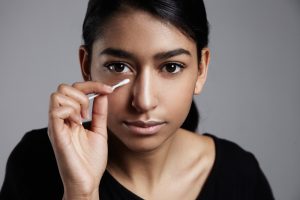[toc]
In the world of hairstyling and hair care, widow’s peak has a bad rap. Many people associate the peak with balding and hair loss whereas others consider it a hindrance to achieving their hair goals.
But does having a widow’s peak really put a damper on all of your hair dreams? Or are people exaggerating the cons of a widow’s peak hairline?
What is a Widow’s Peak?
To start, let’s discuss what a widow’s peak is. It’s a genetic hairline trait that manifests as a small, V-shaped patch of hair at the top of where your hairline meets your forehead. The term “widow’s peak” comes from an old tradition where widows used to wear pointed hoods or headdresses. They were so pointed in the middle, they often resembled the letter “V.”
Most hairlines are rounded, but people with a widow’s peak have a more pointed hairline. Some people have a subtle widow’s peak whereas others have clear and obvious v-shaped and pointed hairlines. You can easily hide your widow’s peak hairline when you let your hair down, but it can also be easily seen if you pull all of your hair back and tie it up.
What are the Causes of a Widow’s Peak?
The exact cause of a widows peak remains unclear. Currently, the assumption is that this hairline is an inherited trait. If you have a widows peak, someone in your family might have one, too. There are no studies that prove its link with genetics, but a widows peak hairline running in the family is a common occurrence.
There isn’t enough research to prove that a single dominant gene is a cause behind a widow’s peak. Many genes could have been involved.
Widow’s peak is also often associated with a few genetic conditions, which includes:
- Donnai-Barrow syndrome. A genetic condition caused by mutations in the LRP2 gene. It causes unusual ears, eyes and nose features.
- Frontonasal dysplasia. A rare genetic condition that triggers an abnormal development of the face and head.
- Aarskog syndrome. This genetic disorder often affects men more than women. The symptoms of Aarskog syndrome include abnormalities of the limbs, genitals and face, as well as short stature.
- Opitz G/BBB syndrome. This condition is triggered by mutations in the SPECC1L, MID1 gene or chromosome 22.
Apart from the genetic aspect of a widow’s peak, you can also develop it when your hairline starts to recede due to aging or hair loss.
Is Widow’s Peak a Sign of Balding?

One of the concerns related to having a widow’s peak (especially for men) is its potential link to baldness and hair loss.
For men, it’s natural to lose a little bit of hair as they age. By the age of 35, 66 percent of American men will experience some degree of hair loss. By 50, more than 80 percent will display a mature hairline and significantly thinning hair. But men who suffer from male pattern baldness (MPB) experience hair loss as early as the age of 21.
Given how common hair thinning and loss is among men (even in women), distinguishing between condition or genetic-caused baldness and natural hair loss can be difficult.
It’s important to educate yourself on the nature of hair loss so you can easily distinguish the difference between normal and abnormal shedding. It’s normal to lose anywhere from 50 to 100 strands of hair per day. For people with longer hair strands, the loss is more noticeable.
Your hairline can be a factor in hair loss. An innocent widows peak can indicate hair loss or male pattern baldness since hair at the crown and the temples are more sensitive to high Dihydrotestosterone (DHT) levels. So yes, a widows peak can be a sign of balding. If yours is receding or very prominent, it could mean that hair loss is a possibility soon.
But not all widows peak hairlines are automatically a sign of hair thinning or hair loss. It’s best to consult with a doctor first.
How Do You Get Rid of a Widow’s Peak?
But what if you’re not a big fan of your v-shaped hairline, regardless of whether it’s a sign of hair loss? Can you make your widows peak go away?
One of the easiest ways to cover your widows peak is bangs. Cutting bangs soften the shape of your hairline. You can also part your hair on the side instead of the center to keep attention away from the peak. Avoid hairstyles that pull your hair toward the backside, such as a bun or a ponytail.
If you want a semi-permanent option, your local beauty salon offers the following short-term solutions:
- A simple plucking fixes your widows peak problem in no time. The best part is if you don’t like the results, you can let the hair grow back. Otherwise, you can continue plucking the unwanted hair if it grows back.
- You can either have a professional wax your hair or you can do it yourself. If you want to wax your hair yourself, do a small test patch first to make sure you’re not allergic to anything.
- These creams remove unwanted hair and offer a longer solution compared to plucking.
You can shave off your widow’s peak but if you choose this hair removal option, you’ll have a lot of maintenance to do, especially if you darker hair and fair skin. To avoid giving yourself a crooked hairline, you’ll also need a steady hand. But if you’re not a big fan of dealing with stubble, best to ditch the razor for less stress.
If you want a more permanent solution for your widow’s peak, talk to a hair specialist or dermatologist. They may suggest the following treatments:
- Electrolysis removes the hair by applying an electrical current or heat.
- Laser hair removal uses beams of light energy to destroy the hair follicles.
What Hairstyle Suits a Widows Peak?
Having a widows peak isn’t always a bad thing, especially since you can style your hair to complement your v-shaped hairline. Many celebrities rock their widows peaks like a pro (Here’s looking at you, Kourtney Kardashian!).
Try the following widows peak hairstyles for men and women.
For men:
- Undercut. Add some spice to your thinning hair strands with an undercut. This haircut gives your top hair a fuller look while taking attention away from your widows peak hairline.
- Comb-over. If you want a practical solution that doesn’t skimp on your style, go with the comb-over. All you have to do is comb your hair over on either side to emphasize the natural shape of your hair.
- The pompadour. This hairstyle adds height and major texture while concealing your widow’s peak. To style your hair to a pompadour, use a small amount of hair putty and shape your hair as you please. It’s the perfect look for a casual day or a festival.
- Slicked-back. What if you’re not a big fan of excessive styling? Go for a slicked-back look. This style is ideal for men with long or medium-length hair. You can also look like a Disney Prince.
- Buzz cut. A buzz-cut keeps your look nice and simple while concealing your v-shaped hairline. It is also the epitome of a low-maintenance look.
For women:
- Sleek half-up ponytail. Give your hair the best of both worlds with a sleek half-up pony. You get the hair length and an updo all at once. To achieve a sleek half-up ponytail, divide your hair into two sections. Keep the bottom half out of the way by clipping it. Brush the top layer of hair toward the center of your head while calming down the roots with some hair gel. Gather the remaining hair and secure it with a hair tie.
- Natural curls. Make your natural hair the star of the show. Natural curls will never let you down. Just amp up your curls with a curl mousse and scrunch for a more defined look.
- Curls with a side part. Take advantage of the natural curls look by styling your hair to a side part. All you have to do is add more curl mousse to your strands, scrunch and let it dry. Once your hair is dried, create a deep side part on either side of your head. Keep your curls in place with some hairspray. Enjoy a glass of wine while you’re at it.
A widows peak may have a bad rap in the world of hairstyles but what you do with it is what matters most. Whether you want to show it off or downplay your v-shaped hairline, it’s all about your personal preferences.









